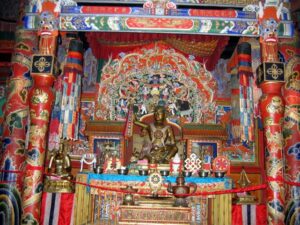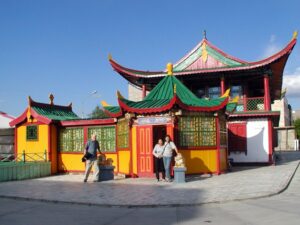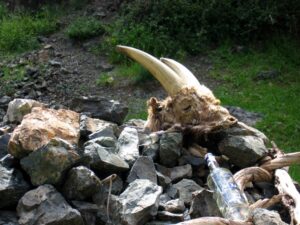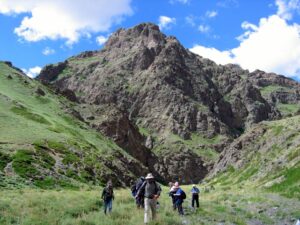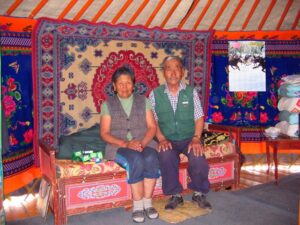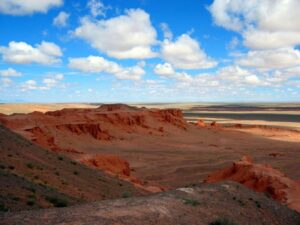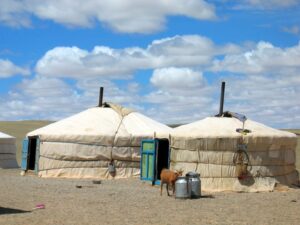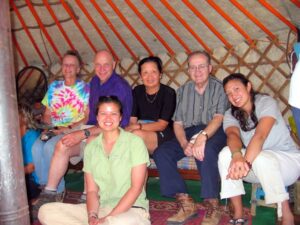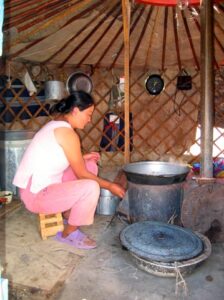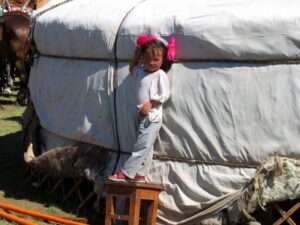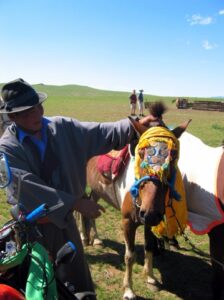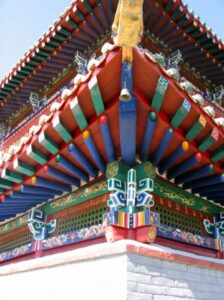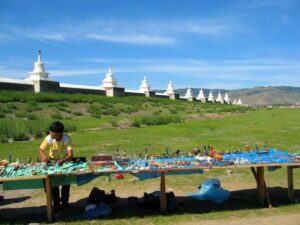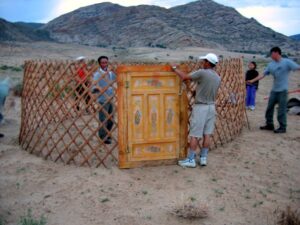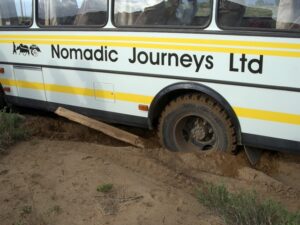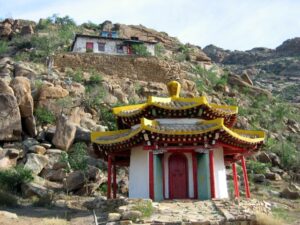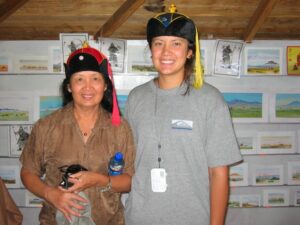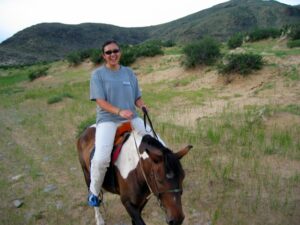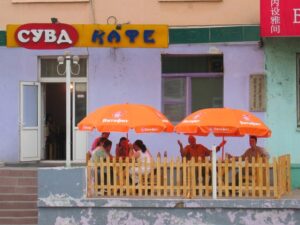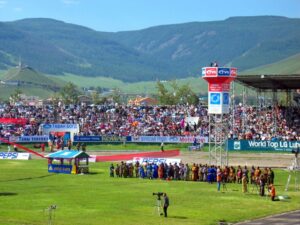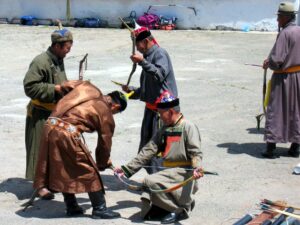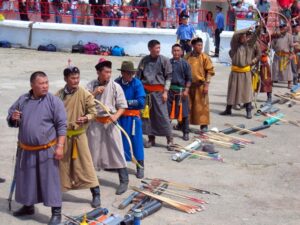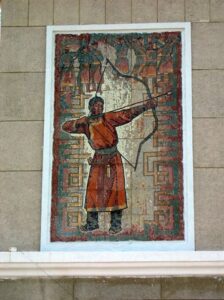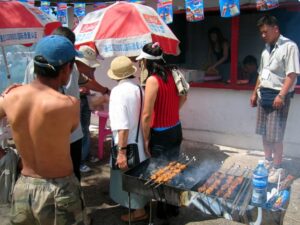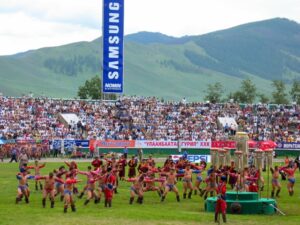Fueled on by descriptions of Mongolia’s Nadaam Festival, we planned a trip to this pristine and remote destination. Mongolia is an outdoorsman’s paradise. Vast tracks of untouched land beckon discovery and hospitable Mongolians welcome you into their gers to force feed cheese and fermented mare’s milk. Escape from Ulan Bator (UB) to experience nomadic Mongolia and of course, take up horseback riding for a day or two! Mongolia is adventure waiting to happen.
Lisa giggles after a bottle of Mongolian snuff is passed around. Mongolians share their snuff bottles as part of their greeting ritual which is called “Khoorog”. When guests visit, the head of the household passes around a snuff bottle, holding it in their right hand and extending it out to the guest as if to shake hands, left hand holding up the right elbow

“Naadam festival, Mongolia”…these three words were feverishly uttered by Becky over and over again until she drove Robby batty and forced him to cave in. We had heard about the Naadam festival from a fellow traveler who had raved about the experience. His description of Mongolia’s three national events (wrestling, horseback riding and archery) sounded like otherworldly scenes and filled us with an aching longing to attend the ceremonies. That was the fall of 2003 and the next opportunity would be July 11-13, 2004 (the Ulan Bator Naadam festival is held annually every July, although there are smaller and more colorful regional festivals held throughout Mongolia at various times during the summer). Becky vowed we would attend UB’s Naadam, come hell or high water. And she didn’t want to do it alone. We have always had a blast traveling with Becky’s sister, Frances, but hadn’t seen her since Egypt ’01. Therefore, we planned our trip to coincide with Franny’s West Point graduation (our grad gift to her) and threw out random invitations to friends and family who were intrepid enough to join us. Much to our surprise, we ended up with a group of eight! (Bob, Ann, Nancy, Richard, Lisa, Franny, Robby and Becky)
For us, Mongolia has always conjured up visions of the untamed: Genghis Khan, camels wandering the Gobi Desert and wild horses galloping across the steppes. Even today, once outside of the capital city, we felt that we had traveled backward in time and were visiting another century, rather than another country. Mongolia’s survival as an independent nation is somewhat of a miracle, seeing how it is sandwiched between sprawling nations of Russia and China.
Mongolia is not the easiest country to get to. Our route would take us through London, Moscow, Ulan Bator and back the same route. An alternative was to fly to Beijing and ride the TransMongolian express…however, we were stoked at the opportunity to revisit Moscow and decided going eastward would be a more ideal route.
In addition to Nadaam, we wanted to experience Mongolia’s “highlights”, so we decided booking a tour vice doing it ourselves would be a lot easier, considering our group size. Becky researched various travel agencies and settled on Explore Worldwide, who combined a fantastic itinerary with decent value. Some of the highlights they mentioned on their dossier included a guided tour of the Mongolia’s capital city Ulan Bator (its pronounced “ooLAN BAHter” but is more commonly referred to as UB), excursions in the Gobi desert, Karakorum (Genghis Khan’s ruined capital city), Erdene-zu monastery (Mongolia’s first Buddhist center built atop Karakorum’s ruins), and Jalman meadows (a prime opportunity for us to tramp around the countryside on horseback). In addition, we would have a half day tour of Moscow while in Russia. The itinerary and schedule appealed to everyone and by November of 2003, we had firm commitments.
Mongolian books were eagerly devoured and used as background fodder in preparation for our upcoming travels. Stanley Stewart’s “In the Empire of Genghis Khan: An Amazing Odyssey through the Lands of the most Feared Conquerors in History” won the Thomas Cook travel award and it is easy to see why. He regaled us with his vivid descriptions and made us feel as if we were already there experiencing it first hand…by the time we were done reading the travelogue, we could feel the saddle burns on our inner thighs and smell the vodka oozing from our compatriots. For travel guides, we relied on Claire Sermier’s Mongolia, Empire of the Steppes and the ubiquitous Lonely Planet Mongolia. The only other thing we had to worry about was obtaining a double entry Russian visa (our outbound and inbound flights both stopped in Moscow for a day) but we needn’t have feared. Brigette from Travel The World Visas provided us with fantastic support and zipped us our visas in no time at all. American citizens can enter into Mongolia visa free for up to 30 days so we didn’t have to worry about visa support for Mongolia. Once all of our paperwork was in order, all we had to do was wait for the big day (29 June 04, which arrived surprisingly fast!)
London’s Heathrow Airport is a zoo. Despite the mayhem erupting at 0600 in the arrivals lounge, it was still really easy to track the “Clark Clan” as they emerged weary eyed from their transatlantic flights. Explore Worldwide had arranged for us to pick up our Aeroflot tickets from a representative at a designated time so once we received them, we checked into our flight with no issues. Maybe it was because Air France was the handling agent for Aeroflot and they actually had very nice customer service skills…we would soon find out that dealing with the actual Aeroflot staff would not be as pleasant of an experience. We left Heathrow and flew into Moscow for a brief 24 hour layover Unfortunately, our departure from Moscow would take longer than expected…our flight to UB was grounded due to inclement weather. We should have known better when the pilot came on the intercom system with his best silky smooth voice to reassure us we would be airborne after a slight 15 minute delay. Two excruciating hours later, we were finally off.
Arriving in UB after a 6 hour flight and numerous time zones later, our bodies were all thrown out of whack. We experienced no problems getting through passport control or customs, and were soon greeted by a smiling Alex, who would be our tour leader for the duration of the tour. She directed us over to a small group that was huddled in a corner and we met the rest of our tour group: Ann, Eva, Steve, John, Liz, Gerta, and Ushee. Ann is an experienced traveler who has explored all four corners of the world…she funds her travels working as a social worker in England and little Mongolian children as truly smitten by her. Eva hails from Budapest, Hungary…she has a fantastic apartment in Pest, a great job and an ever greater boss who encourages her to soak in the sun during those rare, sunny moments in the city. She has definitely caught the ‘itchy feet’ bug and has backpacked her way through over 61 different countries…we feel inspired to have met her. Steve is from England and has served as an overland truck driver. He laughs when our Russian built truck gets stuck in ruts and we can only guess that he has been through worse. John and Liz are the dynamic duo from England. John used to run a trekking company in Katmandu and Liz is a doctor. Whenever we are snoozing in our gers, they can be seen on a far off mountain top, climbing to their hearts content. Gerta is one of New York’s best. Originally from Germany, she has lived in Manhattan for over 20 years and has completely adopted a New York attitude. We love to hear Gerta talk and she has been our heroine on more than one occasion when she has put rude line-cutters in their rightful place. Ushee is also from Germany but lives in England with her wonderful husband. She keeps a picture of him in her eyeglasses case which she furtively sneaks peaks from every once in a while. Her daughter lives in Sri Lanka and her description of the island makes us bump Sri Lanka to the top of our “Places to Go” list.
We all mingle and make brief introductions but we are all tired and ready to check into the hotel. Alex senses this and without further to do, rushes us to a van where our luggage has been shoved into. For those folks sitting in the back of the van, we have to perform acrobatic maneuvers to make our way into the cramped seats. Alex reassures us that our van will be converted to a bus starting tomorrow and we feel vastly relieved. Due to the mass influx of travelers for the Nadaam festival, we have to play the hotel shuffle game and our new digs are at the Palace hotel. While it is not located downtown (unlike our originally scheduled hotel), it is a hop, skip and a jump away from the Nadaam stadium grounds, and we are appeased by its proximity to the upcoming games.
Alex gives us some time to check into our rooms, freshen up and fill out some mandatory forms; we have been instructed to link back up as a group in about an hour downstairs in the Palace hotel restaurant. Alex gives us a thorough briefing of our upcoming itinerary and introduces the newest member of our group to us. Roy is from Canada and is an avid traveler. He has been traveling non-stop since his early retirement and has combined the Mongolian trip with a trip to Northern India, interspersed by Beijing in between the two. Roy always makes us laugh when he wears his baseball cap sideways, which he invariably does when he is focusing his efforts on taking the perfect photograph.
Alex quickly breaks the news to us that our itinerary has changed. While we had anticipated flying to the Gobi desert in about a week and were aware of the 10 kg luggage restriction on the hopper flight, we had fully expected to consume the 6 bottles of alcohol we had lugged on the tour before then. However, when Alex briefed us that the flight would be tomorrow at 0700, with an early 0400 wake up call, it didn’t really register…was she for real? How on earth would our luggage miraculously weigh 10 kg overnight? We didn’t want to leave our precious beverages behind, yet we had to ensure we brought adequate clothing to deal with Mongolia’s extreme climates. After the itinerary briefing, our group split off into several factions: those who wanted to visit UB’s Natural History Museum, those who wanted to sleep, or those who simply wanted to get away from the group to do their own thing. We opted for the guided tour of the museum and met our Mongolian tour guide, Temuujin (Genghis Khan’s original moniker). Saying Temuujin is a mouthful so he encouraged us to call him Tim for short. We started off at Sukhbaatar Square, the main square in the heart of UB.
Our rally point was beside Damdiny Sukhbaatar, the Mongolian patriot portrayed astride a galloping horse. He is beloved by his countrymen for being the “hero of the revolution” because he declared Mongolia’s independence from China in 1921. The square has always functioned as a popular rally point for UB’s locals and is most associated with the scenes of 1989 protests that eventually led to the demise of communism. The square actually is very non-descript, and is flanked on all sides by important buildings such as the grey State Parliament house, stock exchange, Drama Theater and the tall, modern cultural palace. Tim gives us a brief introduction to UB but is very soft spoken and we have to strain to hear him. We learn that UB is dominated by communist style high-rise apartment buildings. However, to our surprise, approximately a quarter of a million Mongolians live in the extended ger suburbs on the outskirts of town, making the UB area the most heavily populated in the country. The gers are a popular abode since they protect their inhabitants from the wind, which can be brutal during the extended winter months. Even in the cities, most Mongolians continue to live in a ger, a large white felt tent that can be moved easily and has a universal layout. The door always faces south, towards the back of the ger, the Khoimor, is the place for elders and the most treasured possessions; on the back wall is the family altar, with Buddhist images, family photos and suitcases. The ger camps in Mongolia consist of several canvas and felt tents plus a large dining tent. Each ger used on this tour has 2 beds, a stove, bedding, plus a simple chest and coat rack for clothing. All are hand painted in local style.
The claim has been made that UB is the coldest capital city in the world, being landlocked between its two giant neighbors of China and Russia (up until the 20th century, Mongolia was actually twice its present size and it included a vast tract of land that is now modern day Siberia as well as Inner Mongolia, which is presently controlled by China). It is one of the highest countries in the world, with an average elevation of 1580 meters or 5180 feet.
We tackle UB’s traffic and make our way towards the National Museum of Mongol History. It is a short stroll from the square but we are intimidated by the locals’ erratic driving and fear for our lives as we dodge traffic while crossing the street. We figure out there is safety in numbers and quickly learn that to survive, we must not attempt to sprint across the street at one go, but to simply shuffle across one lane at a time until the other side is reached. It is an interesting experience to dodge traffic but after a few hours, we are all pros. The National museum houses numerous fascinating exhibits ranging from the Stone Age, Turkic and Mongol Empires, Buddhism and Communism and Ethnographics with colorful costumes and accessories from Mongolia’s many ethnic groups but we are all simply too tired and strained to appreciate it. The heat wears us down and it is very difficult to concentrate on Tim’s excruciating detail on all the exhibits. Hence, it is no surprise that the group quickly disintegrates to seek refuge elsewhere. We consolidate as a group a few hours later on the museum’s front steps, exhausted and ready to move on.
Some of us still had the stamina to explore UB so Ann, Franny, Robby and Becky made a break from everyone else who was headed back to the Palace Hotel for some rest and relaxation. We were on our way to find Lenin’s statue, which is still proudly displayed in front of the Ulaanbaatar Hotel. Afterwards, we wandered through town in search of Choidjiin Lam Monastery. The temple complex is located just north of the square and is a pleasant surprise away from the bustling, metropolitan city. It is a complex of temples that no longer functions as a working religious center, converted into a museum in 1942. The complex was well worth a visit with super friendly staff eager to answer any questions we had. Very proud of their country, they patiently explain that Mongolia’s painting, music and literature are dominated by Tibetan Buddhism and nomadism. Tsam dances are performed to exorcise evil spirits and are influenced by nomadism and Shamanism. While they were outlawed during communism, they’re beginning to be performed again. Traditional music involves a wide range of instruments and singing styles. In Mongolian khoomi singing, carefully trained male voices produce harmonic overtones from deep in the throat, releasing several notes at once. Traditional music and dance performances aren’t complete without a touch of contortionism, an ancient Mongolian tradition. We are grateful for their explanations as it will serve as a good foundation for our dinner experience tonight as well as our upcoming trek into the countryside tomorrow. We spent about an hour here admiring the temples, sculptures and thankas before flagging down a taxi back to the Palace Hotel.
Tonight, Alex had arranged for a group dinner in downtown UB at a circa 1918 red temple that has been transformed into a ger-restaurant. Meals in Mongolia, as we would quickly discover, are always served in the following order: a salad appetizer, main meal consisting of meat and rice, and lastly, tea and dessert. Our group meal at the ger-restaurant was a real treat since Alex had phoned ahead and coordinated to have some local musicians perform for us. With very little fan fare, the musicians arranged themselves and their musical instruments just inside the main entrance of the ger. It was a really nice treat to have ancient Mongolian instruments performed for us, with the performers dressed in traditional Mongolian garb. One of the most melodic instruments was the horse head fiddle, which is shaped as a trapezoidal box that is connected to two strings of horsehair and played with a bow made from horsehair. The best surprise of the evening was when a trio of girl gymnasts (aged 12, 10 and 9) showed up and performed some unbelievable acrobatic stunts for us. Who knew the human body could contort itself into so many amazing positions? We eagerly snapped away with our cameras and marveled at how synchronized the tiny gymnasts were.
Even though all of us were extremely tired, we were happy that Alex had arranged such a nice first evening together. We were ready for some sleep though and caught taxis back to the hotel for a few hours of rest before our early morning flight to Dalenzodgad (South Gobi Desert) tomorrow. Day one has left us with vivid impressions of UB. Our initial feel for Mongolia’s sleepy capital is that is has the atmosphere of a neglected 1950s European city. The old soviet cars and buses are slowly being replaced by newer Japanese versions, but cows still wander the roads, goats sift through rubbish, and monks dressed in red/orange cloth walk alongside traditionally dressed men and women, as well as the city’s fashion conscious nouveaux riche.
0400, 2 July 2004. Day two of our Mongolian adventure. It is WAY too early in the morning for us to register the fact that our telephone is ringing incessantly for our wake up call. We stumble downstairs to have breakfast in the Palace restaurant. Amazingly, the chefs had gone all out in the wee hours of the morning to prepare us hot dishes such as steamed rice and sautéed fish (yes, we are talking about breakfast!), as well as the more traditional breakfast dishes of sausages and fried eggs. We ate quickly as the group had agreed to be on the bus by 5 am, with our luggage separated into two piles (baggage that would remain in UB and baggage we would attempt to take with us to the Gobi desert).
While we all had excess baggage and were painfully over our weight limit, we figured we would come up with a plan. The airport was a brief 15 ride away and we were able to snooze a bit longer while it was still dark out. Upon arrival at the airport, we were all in a state of disarray as we were shuffled from one check in counter to another. Once we arrived to the right check in counter, Bob was first up at bat to face the unsmiling and non-negotiable check in clerks. He was informed that the baggage limit was now 15 kg (good news) but that also included all carry on baggage (bad news). So, while under the gun and in the spotlight, Bob’s quick thinking saved us all a ton of money. He simply grabbed Lisa’s handbag (yes, a ladies purse) as well as a half empty plastic bag and claimed them as his “carry on” baggage, receiving a startled glance from the attendant (maybe Air Mongolia has a “don’t ask, don’t tell” policy) as well as on-board luggage tags from Air Mongolia. Of course, his real carry on bags were hidden from view and remained un-weighed, as they would definitely put him over the 15 kg limit. Armed with the luggage tags, he simply placed them on his heavy baggage and handed the plastic bag and Lisa’s purse to virtually every member of our tour group. And so, the hero of the moment was Bob since we were all able to escape paying excess baggage charges thanks to his spur-of-the-moment, spontaneous scam. What was weird was that the check in clerk didn’t catch on to the fact that she had seen Lisa’s handbag passed along to each member of the tour group, with everyone claiming, “Yes, we packed this ourselves”. Leave it to Bob to outscam the locals!
Once we were all checked in, we had to use our elbows while jostling with the locals to go through the security checkpoint. While we were waiting for our flight, we read in Lonely Planet that “The international Mongolian carrier is MIAT, which stands for “Maybe I’ll arrive today”. Delayed and cancelled flights are quite common due to frequent poor weather conditions. A vast and sparsely populated country with little infrastructure, Mongolia relies heavily on air transport. There are over 80 airports, few of which have paved runways! MIAT, the major internal airline, has flights to most of the provincial capitals, major cities and tourist destinations, but not all of them. There is no computerized reservation system, so you can’t buy a return ticket at the same place you purchase an outgoing one from! Buses are a slow, grueling way of seeing the countryside. Drivers are often drunk and breakdowns are common. Jeeps are an important form of transportation, as only 744 miles out of 29,150 are paved in Mongolia”. Of course, at this moment, the weather takes a turn for the worse and it started down pouring with torrential rain. We were afraid that our early morning hopper to the Gobi desert would be delayed but to our surprise, we boarded the plane and left with no problems.
The view from the plane across the Mongolian steppes was pretty cool once the rain eased up. There would be an immense span of open landscape, dotted with little white gers every so often. Our pilot came over the intercom and announced we’d be landing soon. We looked out and could see no runway so imagine our huge surprise when he landed on a strip of grass! Surprisingly, it was a smooth landing and we were amazed that we had such a nice landing on unpaved land. We wandered over to where our luggage was offloaded and hopped on our diesel powered truck. First stop was at Dalenzodgad city center, where we had to make a quick pit stop to refuel our truck as well as stock up at the town’s super center store on any necessary supplies (alcohol, snack food, toiletries).
We were in for a shock…no one realized that once the truck was topped off, it would make riding in the back of the truck unbearable. The fumes were toxically overpowering and we were woozy after a few minutes of inhaling them. Plus add the fact that we were being roughly jostled across the rugged Mongolian countryside, a lot of us were feeling sick on our first full day of the tour. At one point on the journey, our driver realized that he had been headed the wrong way and we had to backtrack across the rough terrain. You can imagine how low our morale was at that point! It felt as if we would never reach our final destination, which was the Gobi Yurt Camp, located smack dab in the middle of the Gobi Desert. What we failed to realize was that since there are no real “roads” outside of UB, our driver was trying to navigate via terrain features. However, due to the recent rainfall, the “roads” has shifted and his sense of orientation was thrown completely out of whack and he was having a heck of a time trying to figure out where our camp was located. Hence, unbeknownst to us, we had embarked on a journey that felt like we were searching for a needle in a haystack. Amazingly, we finally reached the Gobi Yurt Camp, which felt like an oasis in the middle of the desert. It was located in pristine country, with not a single obstacle in the way of an absolutely phenomenal view of our surroundings (Gurvansaikhan National Park). The atmosphere instantly lifted our spirits, plus Alex told us that lunch would be served right after a cup of hot tea and biscuits. Lunch was simple but delicious. Our hosts ensured that despite the remoteness of our location, they had enough variety of foods to keep our taste buds happy.
After lunch, we scattered to our individual gers and crashed out for a bit. The afternoon hail storm brought our host’s daughters scurrying about our gers to secure the ceiling flap. We were amazed at how quick they were…in about five minutes, they had secured all 10 gers. After our afternoon siesta, Lisa, Becky and Frances decided to get some exercise and quickly found out how high Mongolia’s elevation is! Even a brisk walk/jog to the nearest hilltop a mile away had us all winded and gasping for air. The serene view over a neighboring ger with livestock was worth it, until a guard dog started barking incessantly at the foreign invaders. Apparently Mongolians do not expect many visitors out in the desert steppes and the dog was furious that we were invading its territory. We walked back towards the camp and Frances spotted our first Mongolian astride a camel. She waved furiously at him in an effort to get him to stop and pose for a picture. However, he spurred his camel on and they quickly disappeared over the horizon. Undeterred, Frances gave chase to the moving target and sprinted over the rough terrain to capture his image. When the camel rider realized that she was in hot pursuit, he reared back in surprise/fear and whipped his camel furiously to escape the grasps of this mad woman. The rest of us watched in admiration at Frances’ stamina to give cross country chase to a man and his camel and cheered her on as she sprinted back to us dejected that her first “National Geographic” picture had gotten away! Later on she joked that she never knew that the mere sight of her would incite such repulsion in a stranger. After all that excitement, we retired back to the restaurant ger for our evening meal and then watched an amazing sunset and moonrise. The skyline was stunning and a few hours later, warmed by the wood stoves in the middle of our gers, we all slept soundly beneath the moonlight.
Our dossier informed us that today we would visit the Yol Valley. “Spending the day in the Gobi, we’ll experience many strange natural phenomena. From our camp we drive on desert tracks to the Yol Valley. This gorge sees such little sunlight that there are usually traces of ice even though we are in the middle of the Gobi Desert! Due to the altitude of the surrounding Gurvan Saikhan mountains (reaching 2,300m), a temperate ecosystem exists with Argali Sheep, Ibex and snow leopards living here – as opposed to the desert species one might expect here”. The trip notes also shattered a lot of misconceptions, “many foreigners regard the Gobi as a remote, exotic and mystical place. Its actually full of grass, shrubs and rocks. Oases and sand cover only about 3% of the desert. It is a land of extremes though, ranging from well over 105 F (40 Celsius) in the summer to -40 C/F in the winter.
Gurvansaikhan is 340 km SW of UB, near the town of Dalanzadgad and not far from the Chinese border”. Lonely Planet provided a bit more detail, “unlike other national parks in the Gobi desert, the Gurvansaikhan contains notable attractions, and the facilities (ger camps and roads) are reasonably good. The park contains mountains, dinosaur fossils, extraordinary sand dunes, rock formations and a valley that has ice for most of the year. The part is home to over 200 species of birds, including the Mongolian Desert finch, cinereous vulture, desert warbler and houbara bustard. The sparse vegetation manages to support black-tailed gazelle, snow leopard, ibex, argali sheep, and endangered species of wild camel. A small permit fee is collected at the gate to the Yolyn Am valley, where there is also a small museum of stuffed animals” as well as a replica of the legendary ‘killer worm’ (which falls into the same category as Big Foot, Loch Ness, and the Yeti).
Thankfully, it was a relatively short bus ride from our camping ground to the Gobi National History museum. The stuffed animals seemed a bit forlorn and sad in the displays and the killer worm was laughable but it did give us a rough idea on the types of animal species that live out in the vast Gobi expanse.
While Tim and Alex were coordinating our day passes into the Yol valley, we all had some free time to kill and decided to spend it wandering through the Yol valley’s biggest souvenir strip: a series of ger shops arranged in a row that touted Mongolia’s biggest stamp collection, hand woven camel hair socks, scenic paintings and the like. Shopped out to our heart’s content, we boarded the bus for a short journey to the entrance of vulture valley, where a group of horsemen and camel herders were awaiting our arrival. Five brave souls decided to try riding horses Mongolian style. What this means to the average Westerner is “riding in extreme discomfort” as the riding saddles are made of wood and are very, very small. You are only able to ride the horses if you manage to squeeze your pelvis up into this torture device and urge your horse forward with a forceful “chooo, choooo” command. After a few excruciating minutes, Bob managed to convince Alex to switch horses (she had a coveted western style saddle and Bob could not handle his Mongol saddle anymore). Lisa, Rich and Roy seemed to enjoy their trot through the valley and the rest of the group vowed to have a go at Mongolian horseback riding once we were out at Jalman meadows.
About 2 km into the hike, the riders dismounted and joined the rest of our group for a leisurely walk through the valley. Marmots scurried away as we walked past and several eagles soared magnificently overhead. Our hike intersected a rambling brook several times and we had to hop over to the other side using partially submerged (wet) rocks. Unfortunately, Ushee bit it on one of those crossings and her face made full contact with the ground. We attempted to stop the flow of blood and recommended that she apply pressure to her nose and forehead. Later on we would kid her about her Vulture valley inflicted “war wound” but she was a true trooper and continued hopping over the river crossings with gusto.
A few kilometers into our hike, we reached a segment that remained icy, despite the warm summer temperatures. All of us made our way here with caution, as the path was very slippery. Since the area was so photogenic, an icy arch begged to serve as the background for a Clark Clan photo. The hike through the valley was exhilarating and we were enjoying the phenomenal views that lay before us. After a few hours, we stopped for lunch in an open meadow and soaked in some sunshine. Nancy, Ann (both of them) and Lisa were budding botanists so after lunch, they admired the surrounding plant life and spouted off the scientific names for many of them. The Gobi desert is sure full of surprises, and the bountiful plant life is one of them! After lunch, we had a short hike up to our awaiting ride. Along the way, John found an intact skull of a cow or horse and posed behind it, much to our amusement. We trudged up one last hill and took a breather beside the bus, happy to have spent our morning hiking through such a beautiful part of Mongolia.
After our morning romp, most of us were ready for an afternoon siesta and we crashed in our respective gers. Alex advised those of us who wanted to visit a neighboring ger to meet back at the restaurant ger at 1600 so we could all stroll over there together. Our dossier prepared us for what to expect on our visit, “The Mongolian way of life is nomadic and intimately connected with the ways of animals. Despite urbanization, the traditions of the steppes live on.” Armed with simple gifts like soap, toothbrushes and toothpaste (nomads have to make a special effort to get such simple commodities), we strolled over to pay a call on our neighbors. Alex had briefed us on several customs relating to a ger (do not step on the threshold as this is very disrespectful, instead bend and lead with your right foot forward over the threshold; men and women are normally segregated inside a ger but since we were westerners, exceptions would be allowed for us; and lastly, while seated inside the ger, never stretch out your legs with your heels pointed towards the central hearth as this shows extreme disrespect towards the spirit of the fire). Duly forewarned with mental notes of do’s and don’ts, we visited a 76 year old man and his wife, who lived with their brother’s young daughter (they had adopted her). Once seated inside the ger, the daughter immediately started preparing plates of cheese and bowls of koumiss (fermented mare’s milk that surprisingly tastes great with a lot of sugar!) Afterwards, a snuff bottle was passed to each of us and we were shown the proper technique to take in snuff.
We admired the simplicity of the ger as well as our hosts’ wonderful hospitality. Even though they had not been given any notice of our visit, they were extremely gracious and accommodating. We parted with gifts to the matriarch of the household, extending both hands to give her the gift (as was recommended in our guidebooks). She received the gifts with both hands and a curt nod of her forehead but we could tell that the toiletries were very much appreciated. The daughter was sent outside the ger to subdue the guard dog, which was furious at having strangers desecrate its territory. We do not recommend strolling up to a stranger’s ger without having them secure their dog first, or you will be attacked! We admired our neighbors simple but effective well, which provided ample water for their livestock as well as cooking needs. Our driver demonstrated how to retrieve water from an inflated bladder and we were impressed that the Gobi provided for almost all one’s needs.
We strolled back towards our camp and several of us experienced the camp’s shower contraption. It’s actually quite an ingenious invention: a simple water pump is provided along with a few liters of heated water. You have to furiously pump the handle about twenty times to build up enough pressure to force a fine mist of water out the nozzle. The warm mist of water is more than enough to allow you to lather up and rinse down. It was a wonderful way to get clean while conserving water and we grew accustomed to the simple process. After dinner, we crashed out for a few hours sleep before our early morning departure tomorrow.
4 July, Independence Day! We get up early at a decent hour and breakfast is awaiting us at the restaurant ger. Today is a long and arduous drive (270 kilometers) across difficult terrain but we are grateful that there is one long stop at Bayan Zag (Flaming Cliffs). We are supposed to end up in Saikhan Oboo for the night and once we reach there, we will have left the grasps of the Gobi Desert. We bid our Gobi Yurt Camp hosts goodbye and ask them to pose for a photo for us, which they happily oblige. After that, we hit the road and never become accustomed to the sudden jolts in the ground which send those of us in the back of the bus soaring up towards the roof. The bone jarring is relentless and the group agrees to take turns rotating to the dreaded “back of the bus” seats.
We are happy that the Flaming Cliffs are a short two hour drive away which makes for a perfect break on our arduous journey. Bayan Zag is a Neolithic site where one of the world’s most famous dinosaur scenes emerged (two large dinosaur skeletons on display at the UB Natural History Museum are shown interlocked in a deadly battle to the death. Entitled “Fighting Dinosaurs”, they represent an adult Protoceratops locked in a death struggle with a Velociraptor). Nicknamed “Flaming Cliffs” by the explorer Roy Chapman Andrews, Bayan Zag is the spot where the first dinosaur eggs were discovered in Central Asia. Today, it remains a very popular stop on the tourist trail, with the arid terrain preserving dinosaur eggs that are frequently being discovered by locals and unfortunately sold on the black market. We wonder if they realize that the dinosaur eggs are invaluable national treasures and are disappointed that Mongolians sell these priceless discoveries in an effort to make a buck. We spend about an hour here exploring the magnificent red cliffs and slowly wander back to our bus for the duration of a grueling tour towards Saikhan Oboo.
Lunch is spent amid saxaul bushes, which provide a little bit of shade from the relentless sun. It is bizarre that the saxaul bush grows in abundance around Bayan Zag and nowhere else in Mongolia and we are fortunate to spend some time being surrounded by them. After lunch, we have enough time to make a quick stop visiting another Mongolian family, repeating yesterday’s ger visitation routine. Due to the family’s close proximity to the Flaming Cliffs, they are visited by lots of tourists, as evidenced by the family’s proud display of Polaroid photos adorned on chests and cupboards inside the ger. After our visit, we reluctantly board the bus and prepare ourselves mentally for the duration of the trip. It was actually not as long as we had anticipated and well before dinner, we rolled into Saikhan Ovoo Wild Ger Camp. Immediately before the camp, several Argali sheep were proudly posing on the cliff tops. Some of us were tricked into thinking they were real and eagerly whipped out our cameras to capture them on film. It wasn’t until the bus pulled into the camp ground and we disembarked that we realized the sheep had not shifted position at all, and were indeed genuine fakes.
We had our customary tea and biscuits after settling into our gers and rejoiced that this was the first camp that had electricity so we could recharge our batteries. Alex briefed us that there were some temple ruins scattered along the hills opposite our camp so we dispersed for a few hours of exploration before dinner. Robby and Becky decided to check out a nearby monastery and were pleasantly surprised by another Explore tour group who was camping a few kilometers downstream. They claimed to have seen our dinner a few minutes ago, freshly slaughtered for our group. It was the same goat we had seen chained to a fence when we first pulled in but boy did it taste good! Today was John and Liz’s wedding anniversary and they bought beer for everyone, so dinner was a lively affair. After dinner, entertainment consisted of playing pool or card games and it was pleasant to spend a low key night simply relaxing.
Today is another long day’s journey across the country. We are on our way to Karakorum, Genghis Khan’s ancient capital city. The terrain has changed dramatically since we left the Gobi desert and we now find immense tracts of steppes that are awful for our frequent bathroom breaks. We agree that women pee on the right side of the road, men on the left, no peeking allowed. Since there are no boulders or rocks to conceal us, the women are forced to hold up shirts or jackets matador style to conceal another woman who vainly attempts to pee in privacy. The men pee brazenly out into the open fields and do not have to worry about squatting behind an imaginary rock to maintain their dignity. Frances leads the group in yoga, forcing us into weird positions such as bending dog stance or warrior pose. Those who cannot bend simply look on in amusement and we wonder what the Mongolians must think of our weird contortions alongside the road.
We make numerous stops throughout the day to break up the monotony of a long journey. On one of our stops, we see two hairy yaks in the distance and encroach upon them to take their photos. Two young cowboys (aged 8-10) saunter up on horseback and showoff their cattle corralling techniques. They are camera hogs and love the fact that our entire group is eagerly snapping shots of them.
Further down the road, we look up on the left bank and see a town spectacle going on. It appears that we have been fortunate enough to happen upon on a local town’s Naadam festival. We beg Alex to allow us to hang out there and take a few photos and she readily agrees. Eva is allergic to animals so she hangs out beside the bus and suntans but the rest of us eagerly run uphill towards the mini-fest. It is a wonderful experience and we are so grateful that we were able to witness a non-touristy event. The locals are very proud to pose for photos and the numerous Mongolian cowboys dressed in traditional garb make for amazing subject matter. We met a charming Mongolian family who posed for a family portrait, rosy red cheeks and all. The funniest thing was that someone had given this family a tube of toothpaste in the past and brainwashed them into thinking it was mandatory for them to insert in into their mouths for every photograph. The young children ran to get the tube of toothpaste and refused to let us photograph them without toothpaste sticking out of their mouths. Our entire group felt as if we were transformed back into another world and we were honored to witness the locals host an event that was strictly for their enjoyment (not a cheesy show put on for tourists).
While we were busy taking photographs, Bob surprised us all by galloping over the horizon on horseback! Apparently some young kid asked him if he wanted to hitch a ride and of course, Bob didn’t hesitate for a second. It was a hilarious site to see a Western cowboy riding through the Mongolian steppes and Bob thoroughly enjoyed his moment in the spotlight. The locals were duly impressed to as they fully expected to see him bucked off the horse but Bob held on for the duration of the ride, much to the kid’s chagrin who thought he could get a chuckle seeing a westerner tumble off his horse. Alex finally had to urge us back to the bus since we did have a destination to reach and this was not it. So reluctantly, we boarded back on the bus full of excitement and funny stories of what we had experienced at the fest. John and Liz had been pulled into a ger where Liz was the only woman amidst a crowd of men. They both were offered tons of airag and enjoyed being the only westerners in a very crowded celebratory ger. The rest of us reminisced being accosted by a very friendly Mongolian woman who came armed with a bucket of airag and a ceramic bowl to welcome all of us. It would have been rude to decline the airag so several of us actually ran away so we wouldn’t have to reject her kind offer. The festival fueled enough energy and excitement for the duration of our journey to Karakorum so that we were surprised when we reached our campsite a short while later.
Our lodgings tonight were at the Karakorum Yurt Camp and we were quickly assigned our gers. Alex arranges our dinner tonight and asks us if we would like another rendition of traditional Mongolian music/acrobatics and we eagerly agree. Dinner followed by music, singing and acrobatics is a great way to spend any night and we all enjoy the entertainment put on for us. Afterwards, we each retire to our own gers and prepare to visit Genghis Khan’s historic city tomorrow.
Lonely Planet provides good background material that enables us to appreciate tomorrow’s visit to the fullest, “The Mongols had little inclination to ally with other nomadic peoples of northern Asia. They remained little more than a loose confederation of rival clans until the late 12th century, when a 20 year old Mongol names Temujin emerged and managed to unit most of the Mongol tribes. In 1189 he was given the honorary name of Genghis Khan, meaning ‘universal king’. The Genghis Khan imprinted in the memory of the west bears little relation to the Chinggis Khaan revered by Mongolians. Not only is the spelling different, but to Europeans images of war mongering, mercilessness and brutality reigns, whereas to the Mongolians his name embodies strength, unity, law and order. In 1220, Genghis Khan decided to build the capital city of his vast Mongolian empire at Karakorum. Building was completed by his son, Ogedai Khan, after Genghis’ death, but Karakorum served as the capital for only 40 years before Kublai Khan moved it to what is now Beijing. Following the move, and the subsequent collapse of the Mongolian empire, Karakorum was abandoned and then later destroyed by hordes of Manchurian soldiers. Whatever was left was used to help build the Erdene Zuu monastery in the 16th century, which itself was badly destroyed during the Stalinist purges”.
6 July, 0700. We awake and have a quick breakfast before loading the bus with our luggage. It is a short ride to Karakorum and Alex has agreed to give us a quick briefing on Buddhism. She downplays her knowledge on Buddhism but has enough material to keep us enthralled for a 15 minute lecture. We learn that Erdnezu Monastery and Buddhism are intertwined and inseparable as Mongolians have always taken wholeheartedly to Tibetan Buddhism and the links between Mongolia and Tibet are old and deep. Once in a lifetime, every devout Buddhist Mongolian tries to reach the holy city of Lhasa; the Tibetans in turn have relied on various Mongolian tribes to sustain their power. In Mongolia at the time of the communist takeover in 1921, there were 110,000 lamas (monks) living in about 700 monasteries. Beginning in the 1930s, thousands of monks were arrested, sent to Siberian labor camps and never heard from again. Monasteries were closed and ransacked and all religious worship and ceremonies outlawed. Not until 1990 was freedom of religion restored. Since then, there’s been a phenomenal revival of Buddhism. Monasteries have reopened and even some ex-Communist Party officials have become lamas. Erdnezu Monastery, the first Buddhist center built on Karakorum’s ruins, has likewise seen a huge resurgence over the past decade. Renovations have attempted to restore Erdnezu to its former glory and we are duly impressed. It is easy to see why this is one of the most popular excursions for most tourists from UB.
We start our morning tour learning that Erdene Zuu (which means “hundred treasures”) was the first center of Lamaism in Mongolia. While construction on the monastery commenced in 1586, it took over 300 years for it to be completed. In its heyday, there were between 60 to 100 temples inside the complex, as well as 300 gers and over 1000 monks in residence. However, Karakorum’s curse hit and the monastery was abandoned and vandalized by invading Manchurians. Sadly, during Stalin’s purges, all but three of the existing temples were destroyed and an undetermined number of monks murdered. From the 1930s until 1965, Erdene Zuu remained closed and off limits, but in 1965 the political climate shifted enough to allow Erdene Zuu to be reopened as a museum only, with religion forbidden from being practiced. Once communism fully collapsed, Erdene Zuu was reopened as a monastery, although today it is nowhere close to its original grandeur.
Erdene Zuu is enclosed in an immense walled compound, with 3 temples that are dedicated to the 3 stages of Buddha’s life: as a child, adolescent and adult. The main, central temple is called the Zuu of Buddha and has statues of Buddha as a child. Inside one of the temples is a statue of Bogd Zhonghov, who is credited for spreading Lamaism to Mongolia. We wander towards a functional monastery, where the monks are performing their morning chants and rituals. While it is extremely photogenic inside the monastery, we resist the temptation to take photos as it is considered disrespectful to interrupt their daily services. Instead, we gather outside the monastery and keep an eye out for the occasional red-robed monk scrambling across the complex as we consider him free game. Our group eventually consolidates again and we head outside the monastery complex’s walls to stroll towards Karakorum’s ruins. Originally there were four turtle rocks, each of which marked the boundaries of the ancient city of Karakorum. However, today there are only two stone turtles in existence. Alex tells us that amazingly there are shards of turquoise tile ceramics from Karakorum’s original temples. They are located a short stroll from the turtle and we are able to see thousands of shards submerged beneath mounds of dirt. We wonder if Mongolia will ever undertake the project of rebuilding Karakorum to its former glory but doubt they will, considering how many shards are horded by tourists on a daily basis! Fascinating relics from Genghis Khan’s era, we are amazed that the site is open to the public’s scrutiny.
There are plenty of entrepreneurial souvenir hawkers set up outside of Erdene Zuu’s walls and a few members of our group split off in search of that perfect Mongolian souvenir. After everyone has had the opportunity to shop to their heart’s content, we board our bus and drive a short distance to a small valley overlooking Karakorum. Interestingly, a phallic rock is hidden in the valley and local tradition tells us that any woman who touches the rock will become pregnant within the year. Needless to say, all the women in our group kept their distance from that rock! Instead, we focus our energy on consuming lunch, which is quite tasty. After lunch, we prepare ourselves for the hot journey to Hogno Khan Mountain range, which will be our haven for the next two days.
The journey was hotter than expected and we spent the last half hour on the bus suffering in the sweltering heat. You can imagine our relief when we reached Hogno Khan Ger Camp and could get off the stuffy bus. We were given ger assignments and the customary tea/biscuits routine upon arrival. Bob, Ann, Lisa, Richard and Nancy decided to arrange horse back riding for their afternoon entertainment. Meanwhile, everyone else decided to do their own thing and folks could be seen scaling the nearby rocks for a phenomenal bird’s eye view over our camp. Our mountain retreat was wonderful and we had no complaints except for the locusts plague. Grasshoppers were everywhere on the ground! Whenever we would take a step, grasshoppers would go flying in a million different directions. Some of us hated walking around outside as we could just imagine our Buddhist counterparts angry with us for killing all those grasshoppers with a crunchy crunch beneath our feet. Other than that, the campsite was a relaxing spot and we enjoyed a tranquil night here.
Today’s laidback itinerary included a visit to Erdene Khombo, a nearby monastery that is run by a female abbot. Alex had given us the option of riding back from the monastery on the bus or for those of us who were eager to stretch our legs, an opportunity to hike back to our base camp through the Hogno Khan Mountains. We were warned to wear comfortable hiking gear as the hike would take a few hours and would require some physical exertion.
We loaded onto the bus after breakfast and were on our merry way until our bus became stuck in a rut. Our driver calmly urged us to sit tight and attempted to rock the bus back and forth in an effort to get it out of the ditch but to no avail. We had been through tight spots before on the journey and had complete confidence in our driver’s ability but soon it became evident to all of us that we were not going anywhere! We were truly stuck in a tight spot so despite our driver’s entreaties, we hopped out to survey the damage. No wonder we were not going anywhere. The rear tire was hitting a tree stump and the front was wedged against a boulder. Thankfully, we had basic tools on the bus so while Timujin began sprinting back towards base camp to seek some help (our reserve jeep might be able to tow us out of the jam), Robby and our driver decided to take matters into their own hands. Armed with planks of wood, Robby began digging around the buried tires. The ground was not giving way easily so he switched over to the front tire and attempted to roll the boulder away. Our driver appreciated the assistance and the two of them began animatedly rocking the boulder back and forth and finally managed to roll it away. In the mean time, those of us standing around decided to take some funny pictures of the entire event. The driver had attached a wire cable to the front of the bus in preparation for the upcoming towing. We thought it would be a riot to pose along the cable in various positions of strain, as if we were playing tug of war against the bus. However, our driver misread our attempt at humor and truly believed we were all trying to pull the bus out. So he hopped into the driver’s seat and gunned it hard. We couldn’t believe what was happening! Despite the fact that all of us were barely holding onto the tow cable, slowly but surely that bus started rolling forward. Once we were unstuck, our group let out a big cheer and continued on our way. Our proud driver was beaming from ear to ear, satisfied with our group and steadfast in his belief that we had “towed” the bus out. However, our group consensus attributed our rescue to Robby’s effort to dig up the boulder along with the power of persuasion: once our driver saw a dozen folks pulling the tow cable, he really believed the bus could be pulled out.
Meanwhile, the morning horseback riders at base camp reportedly saw an ashen faced Timujin sprinting the last leg of the journey to report that help was needed ASAP since our bus was stuck. They laughed at poor Tim who was not accustomed to sprinting cross country and was drenched in sweat and worry. Little did he know that our bus driver decided not to await the cavalry and had already continued our journey towards Erdene Khombo. Along our short trip there, we saw a blue parking sign in the middle of a herd of goats. It was similar to the blue “Park Platz” signs one can see all over Germany. How it ended up in the middle of Mongolia surrounded by hundreds of goats was beyond us but we asked Alex if we could stop for a funny photo op. She agreed and Roy, Eva and Ushee cautiously crept up towards the goats. Despite their slow approach, the goats sensed their arrival and they started backtracking equally as slow. Only one silly goat decided to make friends with us and he began approaching our group as if we were long lost friends. Before long, Robby and the goat were playfully locking horns and shoving each other around. We decided we had killed enough time and jumped on the bus for the last short leg to the monastery.
The lady abbot was present to receive us and our group was in dispute as to whether we should continue without Tim or wait for him to arrive by jeep. Most of us were willing to wait although we were being pushed to start the tour without him. We compromised by deciding that we would start the tour after briefly shopping at an arts/crafts store located on the monastery grounds. Some beautiful water color and oil based paintings were purchased, along with Alex’s silly felt hat which she stated would fit right at home back in England. After delaying as much as we could, we finally started our tour. Sure enough, a short while later Timujin emerged from the jeep to catch up with our group.
The lady abbot gave us a brief synopsis of the monastery’s history. In its heyday, there were numerous lamas present for religious ceremonies. However, during Stalin’s purges in 1937, the monastery was completely destroyed and over 2000 lamas executed. What remains today is a mere shadow of the original complex. Headed by women, the monastery plays host to two or three lamas and it is doubtful that it will ever regain its former prominence in the Hogno Khan valley. We climb to a temple that overlooks the valley and can see brick ruins from the original complex. They have been preserved so we can remember the atrocities that were committed here long ago. The rest of the view overlooking the valley is wonderful and it seems so peaceful here; it is hard to imagine that so many innocents were murdered here because of religious intolerance.
Afterwards, Alex urges us to hike through the valley towards another monastery’s ruins and we run into a French tour group along the same trail. It is an easy hike up the valley and Alex makes frequent stops to feed us dried papaya and mango strips. One of the monastery’s dogs decides he is also one of our guides and he never lets us out of sight. We try to feed him some fruit slices but surprisingly, the dog prefers to lick suntan lotion from John and Liz instead. We hope he doesn’t get sick but he’s a young, animated and silly dog, jumping excitedly from our group over a stream and back beneath the bushes, as if he is overjoyed at having new strangers to play with. We have a few minutes to explore the monastery’s ruins and afterwards, our group decides to split into two: those who want to hike and those who want to ride. The hikers bid farewell to the group and then proceeds on the most strenuous part of the journey, straight up to the top of Hogno Khan Mountain. We make one brief stop to catch our breaths and the group decides to push on towards the top so we can admire the view from the best vantage point in town. And it truly is fantastic, with spectacular views in all directions. We decide on a group photo and lounge out on the of rocks to consume a can of peanuts that Alex has thoughtfully brought with her. After relaxing in the sun’s rays for a while, we make our way back down the mountain and are warned by Alex that this is even more treacherous than climbing up it. Therefore, we take our time going down and pause for a brief moment to admire a Cliffside eagle’s nest. The nest is huge and we can only imagine how massive the eagles are. The rest of the hike is fairly easy and a few hours later, we are back at base camp to rest our feet. By that time, the camp is already abuzz with Robby’s heroics as well as Tim’s sprinting ordeal and we laugh about our morning experience.
That afternoon, Alex asks us if we’d like to join her on an excursion to a nearby lake, so we can admire the birdlife. We all agree and pile onto the hot bus. A few minutes later, we are at the edge of what seems to be a marshland and Alex instructs us to walk straight ahead to reach the lake. However, as we walk through the fields, it’s like we are all bit actors in a horror flick because hundreds (if not thousands) of frogs/tadpoles are everywhere on the ground. Where they have come from is not know and we do not see any birds of prey feeding upon them. The frog population is way out of control and we know that with every step we take, we are killing some of these poor creatures as they cannot possibly escape our intrusive footsteps. What is frustrating is that no matter how many hapless frogs we kill, we are no where nearer to the invisible lake. Finally we give up dejected and as we make our way towards Timujin and the awaiting bus, he grins and points towards another direction and tells us that the lake is located there. Alex explodes in anger and asks him why he let us wander around aimlessly in the marshland and he shrugs it off, saying he was wondering why we wanted to “walk with the frogs”. A few of us are determined to see this lake and finally find it but most folks are waiting by the bus, ready to head back to base camp.
We finally leave, just as an entrepreneurial horseman comes galloping furiously towards our group, trying to see if anyone wants to ride to the lake on horseback. Too bad he is a day late and a dollar short, because his scheme does sound highly enticing after our miserable excursion with the frogs. Richard has the entire group rolling with his experience in the marshlands. He has a phobia of frogs anyway and being in an area where is he surrounded by thousands of frogs is akin to Indiana Jones being dropped into a pit full of snakes. As he was gingerly wading across a small river (trying carefully not to step on any frogs or tadpoles), he trips and falls into the river. In a flash, he has bolted upright and sprints his way back to the bus. Hours later, he claims he can still feel thousands of frogs crawling all over him despite his constant scrubbing in the shower to rid himself of that awful feeling.
That afternoon, while the rest of the group is relaxing in their gers, several of us decide to try horseback riding. Bob, Ann, Frances, Becky and Robby decide to give it a go and enjoy a long ride through the valley. We return to base camp around dusk and by then, feel as if we have bonded with our horses. Despite our growing love for our horses, we are still ready to dismount as the Mongolian saddle is extremely uncomfortable and has rubbed us raw in some areas. Despite the discomfort, it was the first real horseback riding experience for Becky and Frances who are thrilled to have experienced it in the Hogno Khan mountain range. We sleep well that night in anticipation of heading back to UB tomorrow and having a chance to mingle in a bustling city again.
We were excited to head back towards UB today as many of us had Internet cafes, shopping at the State Department Store, and restaurant food on our minds. We had an early morning start after breakfast and experienced bumpy roads the entire way to UB. There were construction crews busy working on the main road so at times, our bus rode parallel to the “main highway”, cutting across farmers’ pastures and meadows.
Upon arrival in UB, Alex recommended we head straight to the only formal portion of our tour today, Bogd Khan Palace. The winter palace was built at the turn of the 20th century and was home to Jebtzun Damba Hutagt VIII, the eighth Living Buddha (Bogd Khan) of Mongolia. It is a simple two story building but at the time it was built, became famous for being the tallest building in Mongolia. The Living Buddha lived here for 20 years (between 1893 and 1903). He was an avid collector of stuffed animals and built up a rather large display of animals from around the world. There are a total of 6 temples within the winter palace grounds and we were a bit put off by the $5 a person camera fee, so Robby became the designated photographer for our group. Tim gave us a short briefing on Bogd Khan, explaining that when the leader died in 1924, the soviet-led communist government of Mongolia forbid any future reincarnations. Sadly, after the 8th Bogd Khan, there were no further Mongolian Buddhist leaders. We spent some time admiring the winter palace grounds and then got back on our bus. Little did we realize but our hotel was literally right across the street from the Bogd Khan Palace. It would have been faster to walk across the road than to board the bus for a short ride to the lobby of our hotel.
We were all grateful to be reunited with our luggage and comfy rooms where we could all take long, hot showers and not have to worry about water conservation. Everyone in the group was happy to be back in the busy Mongolian capital and we all split up to do our own thing. It appeared that everyone made a beeline towards the post office to send cards back to loved ones. Another popular stop was the State Department Store, where an excellent display of Mongolian style felt and silk coats were to be had at very decent prices. After shopping till we dropped, food was next on our agenda and UB catered to our every need. There are excellent restaurants all over the city but one thing is for sure, no one wanted to try traditional Mongolian cuisine for dinner tonight since that was all we had consumed throughout the duration of our tour! Fran, Lisa, Rich and Nancy settled on some delicious Chinese dishes while Bob, Ann, Becky and Robby made fast friends at the Singapore managed, Thai Sapphire Restaurant. Good food and great conversation made for a very pleasant evening in UB.
We were off this morning to Jalman meadows, which promised to be one of the highlights of our tour. First, we made a brief stop at Gandan Monastery, one of Mongolia’s best preserved temple complexes. Gandan is well known for being the largest and most important monastery in Mongolia. At the start of the 19th century, there were over 100 Tibetan Buddhist sum (temples) and Khiid (monasteries) that served the 50,000 residents of UB. Unfortunately, during Stalin’s infamous purges in the 1930s, most of these beautiful temples/monasteries perished, along with their inhabitants and priceless belongings. What sets Gandantegchinlen Khiid apart is that the communists decided to keep it intact as a showcase to impress foreigners of their “religious tolerance”. Therefore, most of the buildings at Gandan are original and it remains one of UB’s most amazing sights. The translation of “Gandantegchinlen Khiid” means “the great place of complete joy” and it is indeed a joy to explore the many temples. There are approximately 150 monks who live and worship here, and we were in time for the early morning incense burning and prayer rituals. The temple complex was truly brought to life with their chants and cadences. We had plenty of free time to explore the complex so we wandered through and marveled at the temples adorned with gold and jewels. The most fascinating temple is the Mejid Janraiseg (Avalokiteshvara) temple. It is a blend of Chinese/Tibetan architectural styles and has an unusual height to accommodate the 25.6 meter tall standing deity. The original deity was disassembled in the 1930s by the Russians who sent it piecemeal to the USSR, but the replica standing there today was funded by donations from Japan and Nepal. It is a hollow statue, containing a storehouse of sutras, medicinal herbs, bundles of Buddhist mantras and even an entire furnished ger inside it! After we had wandered through the Gandan complex at our leisure, Alex herded us onto the bus for our drive out towards Jalman meadows.
The weather took a turn for the worse and we had to don our jackets and rain gear. We made a brief stop at a “highway” rest stop where we stocked up on the shop’s entire supply of chocolate bars, chips and juice. Next to the rest stop was an ovoo (abode of spirits), which is essentially a pile of stones found on top of hills and passes. The ovoo is an old and widespread custom throughout Mongolia and we were told to circle it three times in a clockwise direction, placing our own stones on the ovoo upon completion. After performing the ritual, we boarded the bus for the rest of the trek out to Jalman.
We made another pit stop to have lunch out in an open meadow and felt a light drizzle coming down on us. Another hour on the bus brought us to the dense forest of the Khan Khentii Protected Area (beyond the Terelj National Park). Our ger camp, Jalman Meadows Ger Camp, was located in a remote location next to the Tuul River and we were informed that it was an environmental friendly camp that ran on solar power and windmills. The camp ground was truly wonderful. A yak driven cart brought us our luggage and one of the gers had been converted into a library, which was full of wonderful books/magazines on Mongolia. Because the rain was coming down incessantly, we hid out in our gers and sought refuge at the library. Warm tea was a welcome distraction and Alex informed us that due to the recent wet weather, the river was over-swollen and tomorrow’s water rafting had to be cancelled due to safety reasons. Alex suggested a game of skittles and we agreed, intrigued. Skittles ended up being a fun game that consisted of round pegs and square pegs. The square pegs were mounted into the ground and each team stood behind their respective square pegs, attempting to hit the other team’s square pegs with the round pegs. We had a couple of ‘in the closet’ skittle fans, with Richard donning his university’s skittle’s mascot outfit (inverted baseball cap, funky green/blue striped pants, a candle stick holder and prongs) and the demure Ann killing the opposing team with her skittle skills. Rich’s team dominated after a few close calls and the winners happily guzzled some wine while admiring the beautiful view surrounding our camp. Dinner was served in a relaxed setting and the library got a good workout, with folks avidly reading up on Mongolian tidbits.
10 July: Our last day at Jalman Meadows! We were excited at the thought of horseback riding throughout the beautiful countryside today. Our group broke into two sections, those who wanted to gallop and those who wanted to be led on a leisurely stroll. The strollers had an early morning appointment with their horses so the gallopers simply relaxed around the camp site until the horses were brought back. Today was a stunning day and it looked as if we would escape rainfall. At around 11 am, the first group of riders returned and Ann, Bob, Nancy, Frances, Lisa, Robby and Becky put on chaps and mounted their horses. Frances would learn how to gallop today with her neurotic horse. Part way through the ride, Nancy decided to turn back for a more leisurely stroll through the countryside, reducing the total number of riders to six. We rode onward through some pristine country, with yaks, horses, gers and rivers surrounding us. It was a very peaceful and scenic ride and we could easily see why Jalman Meadows is such a popular spot with most tourists. Jalman Meadows is considered a semi-permanent ger camp located in a true wilderness area in the transition zone between steppe and taiga forest. We loved it because it offered relaxation in such a tranquil setting.
After the late morning ride, we ate a quick lunch at the restaurant ger. Alex offered those interested in a hike down by the river to join her later that afternoon. A few riders didn’t get enough riding in during the morning session and begged for an afternoon romp as well. Everyone seemed to be enjoying themselves in the wilderness setting and the day passed by quickly with everyone in anticipation of tomorrow’s Naadam Festival in UB.
It is 0345 on 11 July and Alex is knocking on our gers’ doors as a wake up call. She does not want us to be late for Naadam and neither do we. As she recommended last night, we have packed all of our gear and simply need to throw on some fresh clothes and stumble towards the awaiting bus. Our ger hosts are standing by the bus to bid us farewell but controversy breaks out when they question whether folks have returned their books back to the library (they are missing four books). Becky, Steve and Lisa inform them that the books have been left within their respective gers as the library ger was locked in the morning but we are made to wait until the book count can be re-verified. We are anxious to set off and slightly annoyed at the delay. After waiting in the dark for 15 minutes, Alex finally demands that we set off because she firmly believes the books will be accounted for in the end. It leaves our hosts in an awkward position because they do not want us to depart until they can verify that no books were stolen. We are focusing on the fact that we have a long journey back to UB and time is too precious to waste squabbling about whether books have been returned or not. Despite our hosts’ entreaties for us to hang out a bit longer, Alex forces our driver into motion and we set off, bidding farewell to a very pleasant campsite.
It is still dark out and we snooze along the bumpy trail back towards the capital city. We want to make sure we get back to the Palace hotel with plenty of time to get to the nearby stadium grounds for the opening ceremony. And because Naadam is Mongolia’s premier tourist event, the roads will be blocked for miles in every direction leading to the city to prevent total chaos from breaking out in the city. This explains why so many Mongolians arrive to the games by horseback. We make great time and are back in less than four hours. Our bus is temporarily stopped by a road block but once the policeman peers in and sees a busload full of foreign tourists, he allows us to continue on towards our hotel. Timujin and the jeep are not as lucky…because he does not possess a Naadam pass, he is not allowed to follow our bus. This is bad news because all of our luggage has been loaded onto the jeep. Alex hands us box breakfasts as we offload the bus and urges us to eat something as today will be a long and hot day.
We are in the hotel lobby at 8 a.m. but the hotel will not allow us to check in early. They do offer to give us one room (Alex’s) so we can all change and freshen up after the long bus ride. We agree to meet downstairs in a few minutes and join the crowds that are already starting to gather on the grounds of the stadium. We gaggle around the entrance to gate 18, which unbeknownst to us is designated as the tourist entrance. A parade of ornately costumed men and women promenade in front of us and it is hard to resist capturing them on film. We are a bit early and wait in line patiently for the doors of the stadium to be opened. We are glad that Timujin and Alex insisted on us arriving early as it gets very crowded and feels like all of the tourists in all of Mongolia have consolidated here for the grand opening ceremonies. The tourist line gets insanely long and we are happy that we are in the front of the queue. Once the doors are opened, it is a scrum to scramble to the front of the line. With elbows and a bit of pushiness, we are finally in and Tim directs us towards “choice seating”. The view is pretty good (we are in the shade) but unfortunately for some of us, massive poles supporting the stadium’s roof are obstructing our view. So we shuffle and shift and try to angle our cameras for the perfect bird’s eye view over the stadium grounds.
The excitement builds as the stadium is flooded and more tourists are shoved into VIP stadium seats than the stadium is physically capable of supporting. With everyone jostled into place, the opening ceremonies kick off with horses trotting around the track and colorful costumes decorating the field. It is a vivid blur of color and music and way more than the eye can behold and the mind comprehend. The opening ceremony lasts for a solid hour with acrobats, dancers, singers, wrestlers, horses and a camel parading around the field, forcing us into sensory overload. The sights and sounds are almost too much to digest but we all agree that the most impressive of the opening ceremonies were the daring stunts the agile acrobats perform on the far side of the stadium. Reinforced by the crowd’s simultaneous “oohs” and “aahs”, the acrobats put on a thrilling and unforgettable performance.
Upon the conclusion of the opening ceremonies, Mongolian style wrestling kicks into full gear. For some strange reason, the tour groups are heatedly rushing their groups out, in an effort to catch all three events in one day! Some background on the Naadam festival: it is the biggest event of the year in Mongolia. Known locally as the “Eriyn Gurvan Naadam”, it stands for the three ‘manly’ sports of wrestling, archery and horse racing. The festival is held annually between the 11th to the 13th of July, which is the anniversary of the 1921 Mongolian Revolution. Mongolians from all over the country traverse rough terrain to converge on the capital to witness Mongolia’s National Games. Horse racing, wrestling and archery are the three age old competitions which traditionally measured the courage, strength and daring of nomads and warriors alike. Wrestling matches are run amongst several competitors simultaneously and end when the first elbow or knee touches the ground. Legend has it that a woman once won a wrestling match, humiliating her male opponent. Because of this, the wrestling costume has been modified to portray the chest in an open fashion, with a closed back. Therefore, no female could ever again trick her way into competing in the ceremonies. The other two events, archery and horse racing, are open to both male and female alike, with the horse races arranged and competed in categories of the age of the horse! All three competitions conclude in a colorful and spectacular awards ceremony for the winners.
The stadium crowds disperse immediately following the opening ceremonies and we are left to enjoy the wrestling events by ourselves. Timujin worries about feeding us and rushes outside to link up with our lunch providers. While we had been briefed that we could eat inside the stadium (and enjoy the wresting matches), for some reason, the plans change at the last minute and we are herded outside to eat our meal on the stadium grounds. Delicious wafts of kebabs/shashliks drift towards our picnic and makes our lunch unappealing…we decide that we should definitely partake in the local cuisine and sample what the locals are eating.
Next on our itinerary is the archery event, which starts at 1400. The heat beats down on us and we have a few minutes to wander around the stadium stalls to shop and talk to the locals. Timujin leads us over to the archery stadium, which is adjacent to the main stadium. The archers are dressed from head to toe in traditional garb, slinging their bows and arrows and aiming towards their targets downrange. Historically, the targets were live marmots, but today’s version is a lot more humane with the targets being fist-sized baskets. They are compact and red, and whoops of happiness erupt whenever an archer’s arrows make contact with them. Adjacent to the archery stadium is a makeshift tent where bouts of laughter, loud conversation and music emanate. Becky and Robby peered in curiously and were pleased to find teams of Mongolians totally engrossed in a local sport known as “bone shooting”. This game consists of participants flicking sheep ankle bones at a target of stacked bones about 10 feet away. The players were focusing their full efforts on hitting their respective targets and this venue proved extremely popular with the locals. The heat beats down relentlessly so our group dwindles down as folks lose interest in the games and decide to spend their time wandering through the many stalls or shopping downtown.
Several weeks ago, Alex had coordinated tonight’s group dinner for us at a nearby Mongolian restaurant. This was a brilliant idea because Naadam lures in way more visitors than UB can support, and attempting to make impromptu restaurant reservations would have proved futile. We thoroughly enjoyed our group dinner and were pleasantly surprised when Timujin decided to show us how to play anklebones (the anklebones of various livestock such as sheep, cow, horse and camel “dominate” each other in a pre-determined rank order. We had to roll our anklebones and see which animal we surfaced and see if it defeated our neighbor’s animal). It was a very rudimentary game but we were hooked! After dinner, Alex gave us the option of being dropped off at Sukhbaatar Square, where we could enjoy several concerts as well as watch the fireworks spectacle later that night. We all opted to hang out in the square and make our own way back to the Palace Hotel. Overall, a thrilling day to experience in UB and we were glad to be a part of the festival.
Our last full day in Mongolia! Today was day 2 of the Naadam festival and we decided to rally in the lobby early in the morning as we were anxious to witness the horse racing. Held several kilometers outside the city, getting to the venue required a lot of advanced planning. Unfortunately, the plan we had discussed the previous night was waylaid. Our driver, who was supposed to pick us up at 0645 was waiting on the Nomadic Journey’s head office to open so they could issue us our boxed lunches. At 0715, we were irritable and anxious to get on the road so we could get choice seating. The bus pulled up a few minutes later (with our yummy lunch boxes) and we were off. The road was crowded with like minded families who were eager to experience the excitement and bond in the camaraderie of the horse races.
In Claire Sermier’s Mongolia travel guide, we read about how the horses are trained for Naadam. With Mongolians being such avid horse lovers, the Naadam horse races are Mongolia’s most popular, whose winner (the horse, not the rider) earns bragging rights for the rest of his/her life! The horses are trained in a methodology hundreds of years old, with special focus on the horse’s age and speed. The first phase is the “weight loss” phase, which begins three months prior to Naadam. The horse is allowed to graze on the best pastureland but is not allowed to gain weight! This is achieved by adorning the horse with a thick felt blanket, where it is led up a steep slope at the hottest time of the day. The horse’s owners use a long wooden pallet and scrape the sweat off the horse, and this is meant to eliminate excess food and increase blood circulation and muscular activity. This continues for several days until the horse’s droppings become firm and brittle. Afterwards, the horse enters into phase two, the “Tar”. This phase consists of the horse running as fast as possible over the distance of one kilometer. It is designed to train the horse how to develop regular breathing patterns. The distance is gradually increased as the horse gets its breathing patterns under control. Once a certain distance is achieved with the horse’s breathing remaining constant, the horse enters the third and final stage, the “Sungaa”. The Sungaa starts approximately 10 days prior to Naadam, where the horse must run a distance of 10 to 13 kilometers at full speed. Four or five days prior to the race, the distance is increased to 15 kilometers. The horse’s breathing pattern is closely monitored and a determination is made on whether it is satisfactory or not. (Unbelievably, if the breathing is not satisfactory, the poor horse is forced to run at full gallop two or three days prior to the competition!) The last portion of the Sungaa is a full observation of the horse. It must stand in a balanced manner, with its droppings examined to be compact and dry. The animal is not allowed to sweat anywhere near the saddle after the race and the blood vessels located under the horse’s skin and near its nostrils must be visible.
With so much focus and training on the horse, it is no wonder that a horse may win the Naadam horse race with or without its rider! They have been trained to continue running the course even if their riders are dismounted at any point during the competition. After all, the focus is on the horse itself and it remains an integral and pivotal piece to the competition, with its rider given secondary consideration. We had been briefed to expect several of the horses to have heart attacks and die along the course of the race. Trained under such grueling conditions, a horse can only be expected to compete in Naadam once in its lifetime and such an experience is an accomplishment in and of itself.
When we finally arrived to the start of the race, we were amazed at the throngs of Mongolians who were gathering alongside with us. Bags of food, blankets and chairs were all in tow and the Mongolians seemed to be making a family affair of it all. Our group settled in an area about half a kilometer from the end of the race. Liz and John split off to catch the race at the end line and Robby and Becky broke away to do the same. The finish line area was such a zoo with spectators sitting on top of whatever they could find to give them a better vantage point (atop their horses, the fence, fire engines and the like). It was super crowded, chaotic and fun. When the riders finally crested over the horizon, you could just hear the excitement in the air. Fans were yelling their favorites on and it was really difficult to make out who was ahead (except for the riders’ colorful jerseys). Binoculars are a must and we gazed through ours to see an orange clad rider hold out just long enough to beat his competitors. It was a very close race with fractions of a second separating the winner from second place. Unfortunately, we also saw a few horses that gave it their all but just didn’t have enough stamina to cross the finish line. The most heart breaking scene was a horse that stopped just shy of the finish line. It had about 10 meters to go and the rider dismounted it and attempted to pull the horse forward, with the crowd urging them on. Sadly, the horse went into cardiac arrest, its legs buckled and it simply collapsed on the spot. After the race was over, a bull dozer simply scooped the horse up and dumped it into an awaiting trash dumpster…it just broke our hearts to see it so close to the finish line and not able to make it. There were several other horses’ bodies that lay on the track and they too were scooped up unceremoniously.
Our bus was waiting patiently for the stragglers to board for our long journey back to UB. The trip was made even longer because of all the traffic headed back into town trying to converge on one road. We commiserated with the numerous Mongolians who had attempted to take short cuts across the grassy fields and had gotten their vehicles stuck in massive ditches or on steep embankments. They looked like they would not be going anywhere anytime soon (anyone heard of AAA or ADAC in Mongolia?)
When we finally arrived back to UB, Alex gave us the rest of the day off to do our own thing until our final group dinner that night, celebrated at an Indian restaurant. Most folks decided to seek refuge from the heat but several of us ended up back at the Stadium, where we joined throngs of locals cheering on our favorite wrestlers. There was definitely an electric excitement in the air and several hours of watching the wrestlers combat each other Mongolian style proved to be an invigorating and thrilling experience, especially since the locals had infiltrated the tourist section and die-hard fans now outnumbered the visitors. An afternoon drizzle cooled UB down a bit and we gathered together one last time for a group dinner. Indian food was a perfect decision and we enjoyed different sensations to our palettes. John and Bob gave short speeches and the groups’ tip kitty to Timujin and Alex, thanking them for their hard work and dedication on the tour. We ended up spending our dinner laughing about the different experiences we had shared along the trip and reminiscing our trip highlights.
Last morning in UB! Fortunately, we were able to sleep in as our morning flight was not super early. Alex advised us to have 2500 Tugrik each for departure tax at the airport handy or that would delay us needlessly when we got there. We bid Roy goodbye (as he was flying out later that day to Beijing before continuing on with his Indian tour) and loaded up the bus for one final trip. Checking in to Moscow was a straightforward process and we bid Timujin goodbye and thanked him for a wonderful tour.
Reflecting back on the tour, we’d have to say that Mongolia was truly a delight. While traveling across the country can be strenuous and bone-jarring, it is the best way to see the gorgeous countryside. Nothing in our preparations made us ready for experiencing life in the Gobi and it was a highlight not to be missed. The local Naadam festival was probably everyone’s favorite experience so we’d recommend that a trip to Mongolia be taken in the summer months, where one’s chances of happening upon a festival can be greatly heightened. Rural Mongolians greatly appreciate simple household amenities like soap, toothpaste, and sewing kits so stock up on those as they make great gifts. Above all, go and have fun…drinking airag inside a ger with jovial Mongolians is an experience you are not likely to forget!







